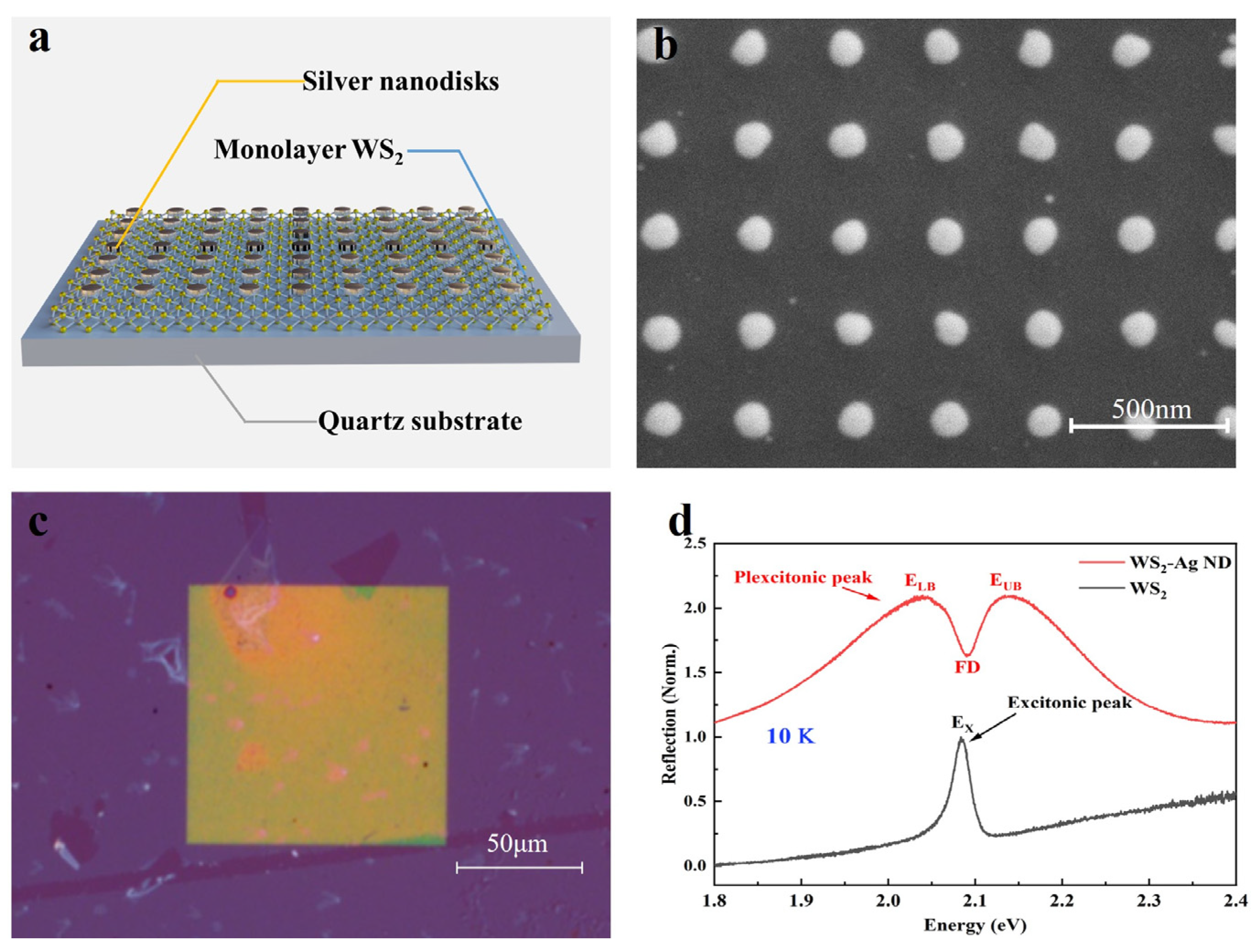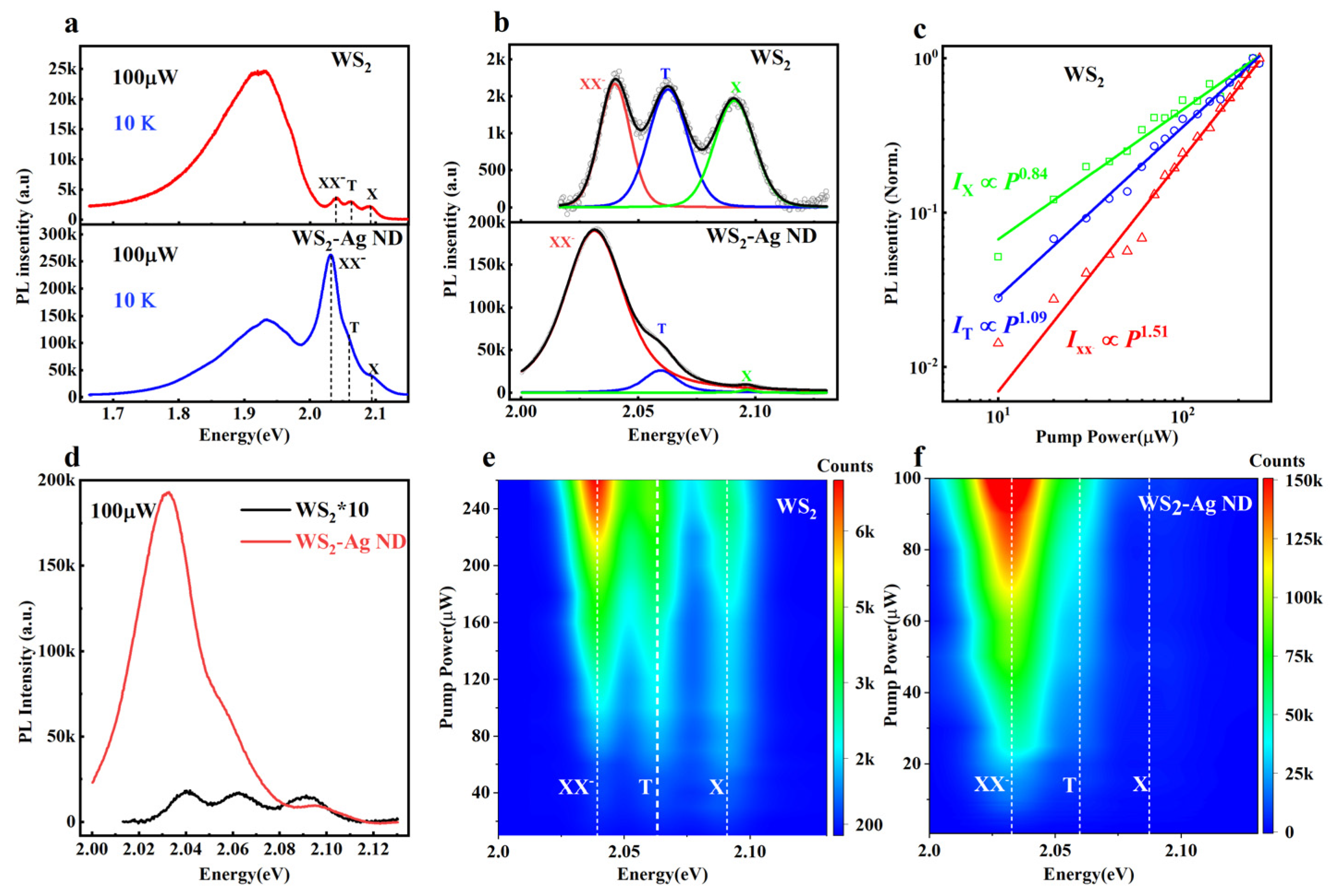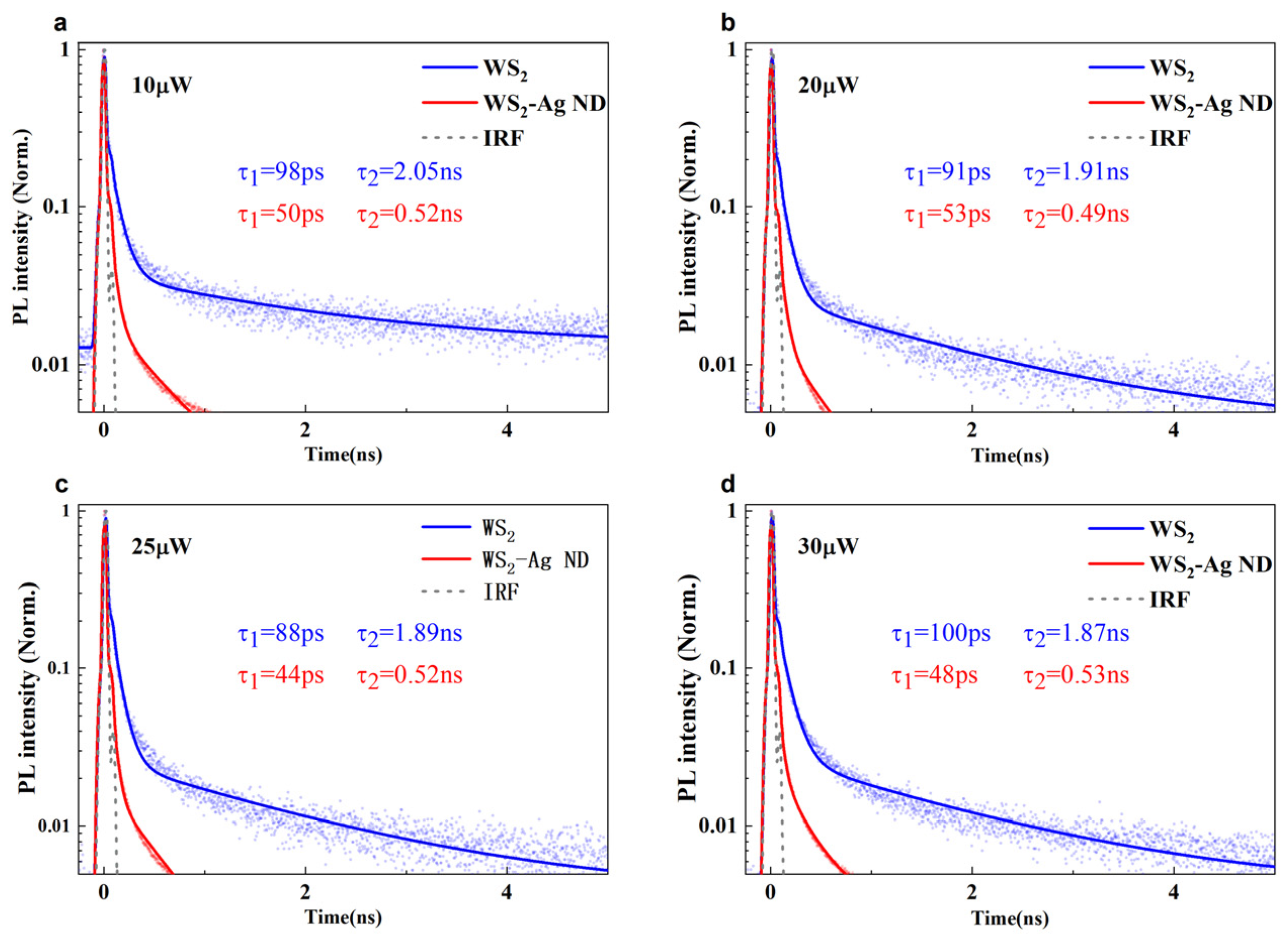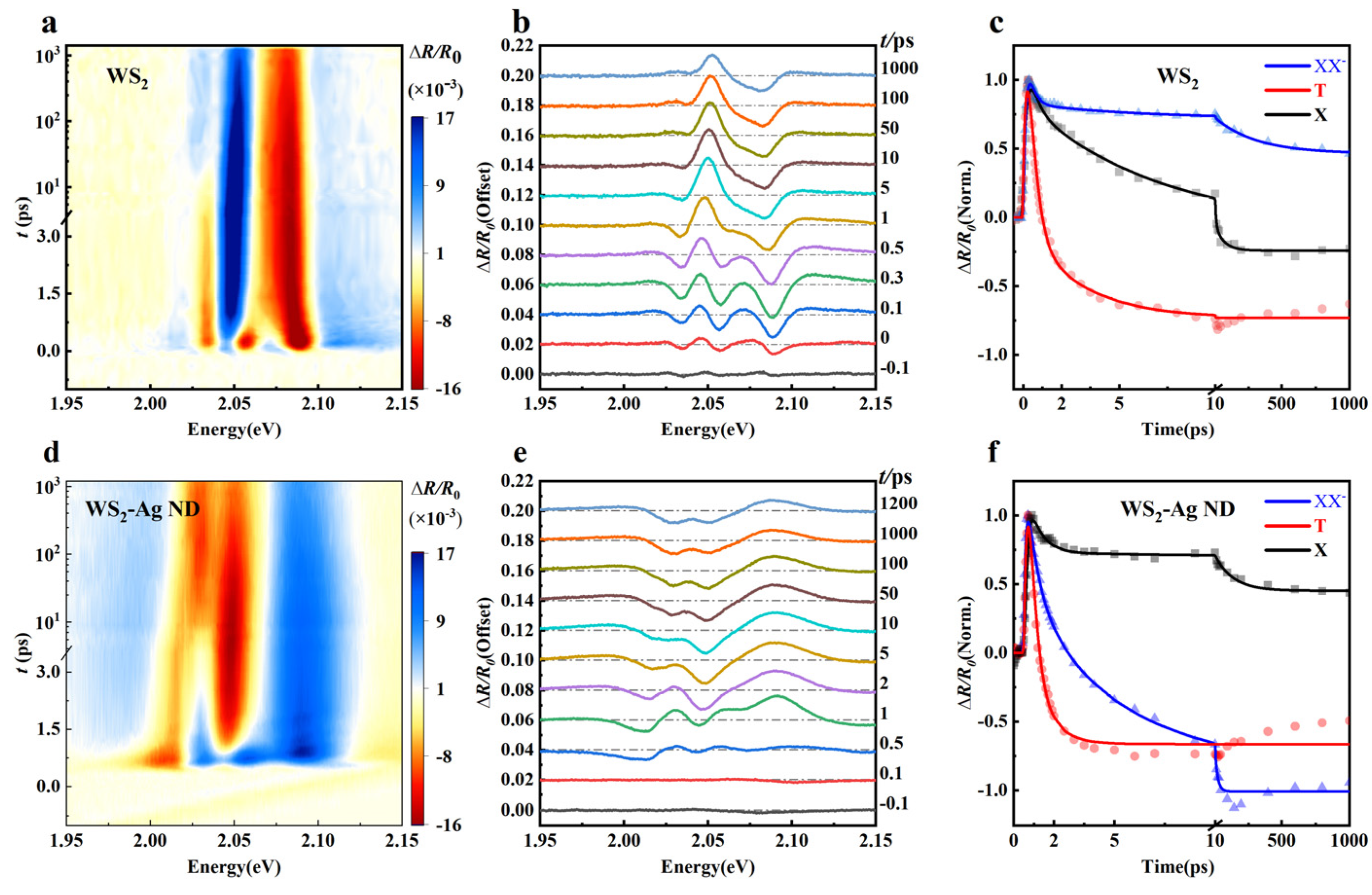Photoluminescence Enhancement and Carrier Dynamics of Charged Biexciton in Monolayer WS2 Coupled with Plasmonic Nanocavity
Abstract
1. Introduction
2. Materials and Methods
3. Results and Discussion
3.1. Steady-State Power-Dependent Photoluminescence (PL) Spectroscopy
3.2. Time-Resolved PL and Femtosecond Pump-Probe Measurements
4. Conclusions
Author Contributions
Funding
Institutional Review Board Statement
Informed Consent Statement
Data Availability Statement
Conflicts of Interest
References
- Novoselov, K.S.; Mishchenko, A.; Carvalho, A. 2D Materials and van Der Waals Heterostructures. Science 2016, 353, aac9439. [Google Scholar] [CrossRef] [PubMed]
- Wang, Q.H.; Kalantar-Zadeh, K.; Kis, A.; Coleman, J.N.; Strano, M.S. Electronics and Optoelectronics of Two-Dimensional Transition Metal Dichalcogenides. Nat. Nanotechol. 2012, 7, 699–712. [Google Scholar] [CrossRef] [PubMed]
- Mak, K.F.; Xiao, D.; Shan, J. Light–Valley Interactions in 2D Semiconductors. Nat. Photonics 2018, 12, 451–460. [Google Scholar] [CrossRef]
- Qiu, D.Y.; da Jornada, F.H.; Louie, S.G. Optical Spectrum of MoS2: Many-Body Effects and Diversity of Exciton States. Phys. Rev. Lett. 2013, 111, 216805. [Google Scholar] [CrossRef] [PubMed]
- Mostaani, E.; Hunt, R.J.; Thomas, D.M.; Szyniszewski, M.; Montblanch, A.R.-P.; Barbone, M.; Atatüre, M.; Drummond, N.D.; Ferrari, A.C. Charge Carrier Complexes in Monolayer Semiconductors. Phys. Rev. B 2023, 108, 035420. [Google Scholar] [CrossRef]
- Barbone, M.; Montblanch, A.R.-P.; Kara, D.M.; Palacios-Berraquero, C.; Cadore, A.R.; De Fazio, D.; Pingault, B.; Mostaani, E.; Li, H.; Chen, B.; et al. Charge-Tuneable Biexciton Complexes in Monolayer WSe2. Nat. Commun. 2018, 9, 3721. [Google Scholar] [CrossRef] [PubMed]
- Paur, M.; Molina-Mendoza, A.J.; Bratschitsch, R.; Watanabe, K.; Taniguchi, T.; Mueller, T. Electroluminescence from Multi-Particle Exciton Complexes in Transition Metal Dichalcogenide Semiconductors. Nat. Commun. 2019, 10, 1709. [Google Scholar] [CrossRef]
- Li, Z.; Wang, T.; Lu, Z.; Jin, C.; Chen, Y.; Meng, Y.; Lian, Z.; Taniguchi, T.; Watanabe, K.; Zhang, S.; et al. Revealing the Biexciton and Trion-Exciton Complexes in BN Encapsulated WSe2. Nat. Commun. 2018, 9, 3719. [Google Scholar] [CrossRef] [PubMed]
- Courtade, E.; Semina, M.; Manca, M.; Glazov, M.M.; Robert, C.; Cadiz, F.; Wang, G.; Taniguchi, T.; Watanabe, K.; Pierre, M.; et al. Charged Excitons in Monolayer WSe2: Experiment and Theory. Phys. Rev. B 2017, 96, 085302. [Google Scholar] [CrossRef]
- Wang, Z.; Dong, Z.; Gu, Y.; Chang, Y.-H.; Zhang, L.; Li, L.-J.; Zhao, W.; Eda, G.; Zhang, W.; Grinblat, G.; et al. Giant Photoluminescence Enhancement in Tungsten-Diselenide–Gold Plasmonic Hybrid Structures. Nat. Commun. 2016, 7, 11283. [Google Scholar] [CrossRef]
- Tugchin, B.N.; Doolaard, N.; Barreda, A.I.; Zhang, Z.; Romashkina, A.; Fasold, S.; Staude, I.; Eilenberger, F.; Pertsch, T. Photoluminescence Enhancement of Monolayer WS2 by n-Doping with an Optically Excited Gold Disk. Nano Lett. 2023, 23, 10848–10855. [Google Scholar] [CrossRef] [PubMed]
- Zhang, W.; Gao, L.; Yan, X.; Xu, H.; Wei, H. Excitation and Emission Distinguished Photoluminescence Enhancement in a Plasmon–Exciton Intermediate Coupling System. Nanoscale 2023, 15, 7812–7819. [Google Scholar] [CrossRef] [PubMed]
- Rozenman, G.G.; Peisakhov, A.; Zadok, N. Dispersion of Organic Exciton Polaritons—A Novel Undergraduate Experiment. Eur. J. Phys. 2022, 43, 035301. [Google Scholar] [CrossRef]
- Sun, J.; Hu, H.; Pan, D.; Zhang, S.; Xu, H. Selectively Depopulating Valley-Polarized Excitons in Monolayer MoS2 by Local Chirality in Single Plasmonic Nanocavity. Nano Lett. 2020, 20, 4953–4959. [Google Scholar] [CrossRef] [PubMed]
- Viarbitskaya, S.; Teulle, A.; Marty, R.; Sharma, J.; Girard, C.; Arbouet, A.; Dujardin, E. Tailoring and Imaging the Plasmonic Local Density of States in Crystalline Nanoprisms. Nat. Mater 2013, 12, 426–432. [Google Scholar] [CrossRef] [PubMed]
- Tang, Y.; Zhang, Y.; Cao, F.; Sui, Y.; Cheng, X.; Shi, L.; Jiang, T. Ultrafast Resonant Exciton–Plasmon Coupling for Enhanced Emission in Lead Halide Perovskite with Metallic Ag Nanostructures. Opt. Lett. 2022, 47, 3916. [Google Scholar] [CrossRef] [PubMed]
- Cao, E.; Lin, W.; Sun, M.; Liang, W.; Song, Y. Exciton-Plasmon Coupling Interactions: From Principle to Applications. Nanophotonics 2018, 7, 145–167. [Google Scholar] [CrossRef]
- Prodan, E.; Radloff, C.; Halas, N.J.; Nordlander, P. A Hybridization Model for the Plasmon Response of Complex Nanostructures. Science 2003, 302, 419–422. [Google Scholar] [CrossRef]
- Miroshnichenko, A.E.; Flach, S.; Kivshar, Y.S. Fano Resonances in Nanoscale Structures. Rev. Mod. Phys. 2010, 82, 2257–2298. [Google Scholar] [CrossRef]
- Du, W.; Zhao, J.; Zhao, W.; Zhang, S.; Xu, H.; Xiong, Q. Ultrafast Modulation of Exciton–Plasmon Coupling in a Monolayer WS2–Ag Nanodisk Hybrid System. ACS Photonics 2019, 6, 2832–2840. [Google Scholar] [CrossRef]
- Huang, J.; Akselrod, G.M.; Ming, T.; Kong, J.; Mikkelsen, M.H. Tailored Emission Spectrum of 2D Semiconductors Using Plasmonic Nanocavities. ACS Photonics 2018, 5, 552–558. [Google Scholar] [CrossRef]
- Rafique, M.Z.E.; Basiri, A.; Bai, J.; Zuo, J.; Yao, Y. Ultrafast Graphene-Plasmonic Hybrid Metasurface Saturable Absorber with Low Saturation Fluence. ACS Nano 2023, 17, 10431–10441. [Google Scholar] [CrossRef] [PubMed]
- Melendez, L.V.; Van Embden, J.; Connell, T.U.; Duffy, N.W.; Gómez, D.E. Optimal Geometry for Plasmonic Hot-Carrier Extraction in Metal–Semiconductor Nanocrystals. ACS Nano 2023, 17, 4659–4666. [Google Scholar] [CrossRef] [PubMed]
- Colin-Ulloa, E.; Fitzgerald, A.; Montazeri, K.; Mann, J.; Natu, V.; Ngo, K.; Uzarski, J.; Barsoum, M.W.; Titova, L.V. Ultrafast Spectroscopy of Plasmons and Free Carriers in 2D MXenes. Adv. Mater. 2023, 35, 2208659. [Google Scholar] [CrossRef] [PubMed]
- Zheng, D.; Zhang, S.; Deng, Q.; Kang, M.; Nordlander, P.; Xu, H. Manipulating Coherent Plasmon–Exciton Interaction in a Single Silver Nanorod on Monolayer WSe2. Nano Lett. 2017, 17, 3809–3814. [Google Scholar] [CrossRef]
- Fu, S.; du Fossé, I.; Jia, X.; Xu, J.; Yu, X.; Zhang, H.; Zheng, W.; Krasel, S.; Chen, Z.; Wang, Z.M.; et al. Long-Lived Charge Separation Following Pump-Wavelength–Dependent Ultrafast Charge Transfer in Graphene/WS2 Heterostructures. Sci. Adv. 2021, 7, eabd9061. [Google Scholar] [CrossRef] [PubMed]
- Wei, K.; Zheng, X.; Cheng, X.; Shen, C.; Jiang, T. Observation of Ultrafast Exciton–Exciton Annihilation in CsPbBr3 Quantum Dots. Adv. Opt. Mater. 2016, 4, 1993–1997. [Google Scholar] [CrossRef]
- Pogna, E.A.A.; Marsili, M.; De Fazio, D.; Dal Conte, S.; Manzoni, C.; Sangalli, D.; Yoon, D.; Lombardo, A.; Ferrari, A.C.; Marini, A.; et al. Photo-Induced Bandgap Renormalization Governs the Ultrafast Response of Single-Layer MoS2. ACS Nano 2016, 10, 1182–1188. [Google Scholar] [CrossRef] [PubMed]
- Wei, K.; Liu, Q.; Tang, Y.; Ye, Y.; Xu, Z.; Jiang, T. Charged Biexciton Polaritons Sustaining Strong Nonlinearity in 2D Semiconductor-Based Nanocavities. Nat. Commun. 2023, 14, 5310. [Google Scholar] [CrossRef] [PubMed]
- Chowdhury, R.K.; Nandy, S.; Bhattacharya, S.; Karmakar, M.; Bhaktha, S.N.B.; Datta, P.K.; Taraphder, A.; Ray, S.K. Ultrafast Time-Resolved Investigations of Excitons and Biexcitons at Room Temperature in Layered WS2. 2D Mater. 2018, 6, 015011. [Google Scholar] [CrossRef]






| X | T | XX− | ||||
|---|---|---|---|---|---|---|
| WS2 (ps) | WS2–Ag ND (ps) | WS2 (ps) | WS2–Ag ND (ps) | WS2 (ps) | WS2–Ag ND (ps) | |
| τrise | 0.27 | 0.09 | 0.27 | 0.24 | 0.16 | 0.10 |
| τ1 | 6.60 | 0.09 | 0.29 | 0.27 | 0.56 | 0.17 |
| τ2 | 64.49 | 0.62 | 2.81 | 1.14 | 3.71 | 3.32 |
| τ3 | 211.84 | 131.45 | N/A | N/A | 292.94 | 20.10 |
Disclaimer/Publisher’s Note: The statements, opinions and data contained in all publications are solely those of the individual author(s) and contributor(s) and not of MDPI and/or the editor(s). MDPI and/or the editor(s) disclaim responsibility for any injury to people or property resulting from any ideas, methods, instructions or products referred to in the content. |
© 2024 by the authors. Licensee MDPI, Basel, Switzerland. This article is an open access article distributed under the terms and conditions of the Creative Commons Attribution (CC BY) license (https://creativecommons.org/licenses/by/4.0/).
Share and Cite
Geng, H.; Liu, Q.; Tang, Y.; Wei, K. Photoluminescence Enhancement and Carrier Dynamics of Charged Biexciton in Monolayer WS2 Coupled with Plasmonic Nanocavity. Photonics 2024, 11, 358. https://doi.org/10.3390/photonics11040358
Geng H, Liu Q, Tang Y, Wei K. Photoluminescence Enhancement and Carrier Dynamics of Charged Biexciton in Monolayer WS2 Coupled with Plasmonic Nanocavity. Photonics. 2024; 11(4):358. https://doi.org/10.3390/photonics11040358
Chicago/Turabian StyleGeng, Huiqiang, Qirui Liu, Yuxiang Tang, and Ke Wei. 2024. "Photoluminescence Enhancement and Carrier Dynamics of Charged Biexciton in Monolayer WS2 Coupled with Plasmonic Nanocavity" Photonics 11, no. 4: 358. https://doi.org/10.3390/photonics11040358
APA StyleGeng, H., Liu, Q., Tang, Y., & Wei, K. (2024). Photoluminescence Enhancement and Carrier Dynamics of Charged Biexciton in Monolayer WS2 Coupled with Plasmonic Nanocavity. Photonics, 11(4), 358. https://doi.org/10.3390/photonics11040358





